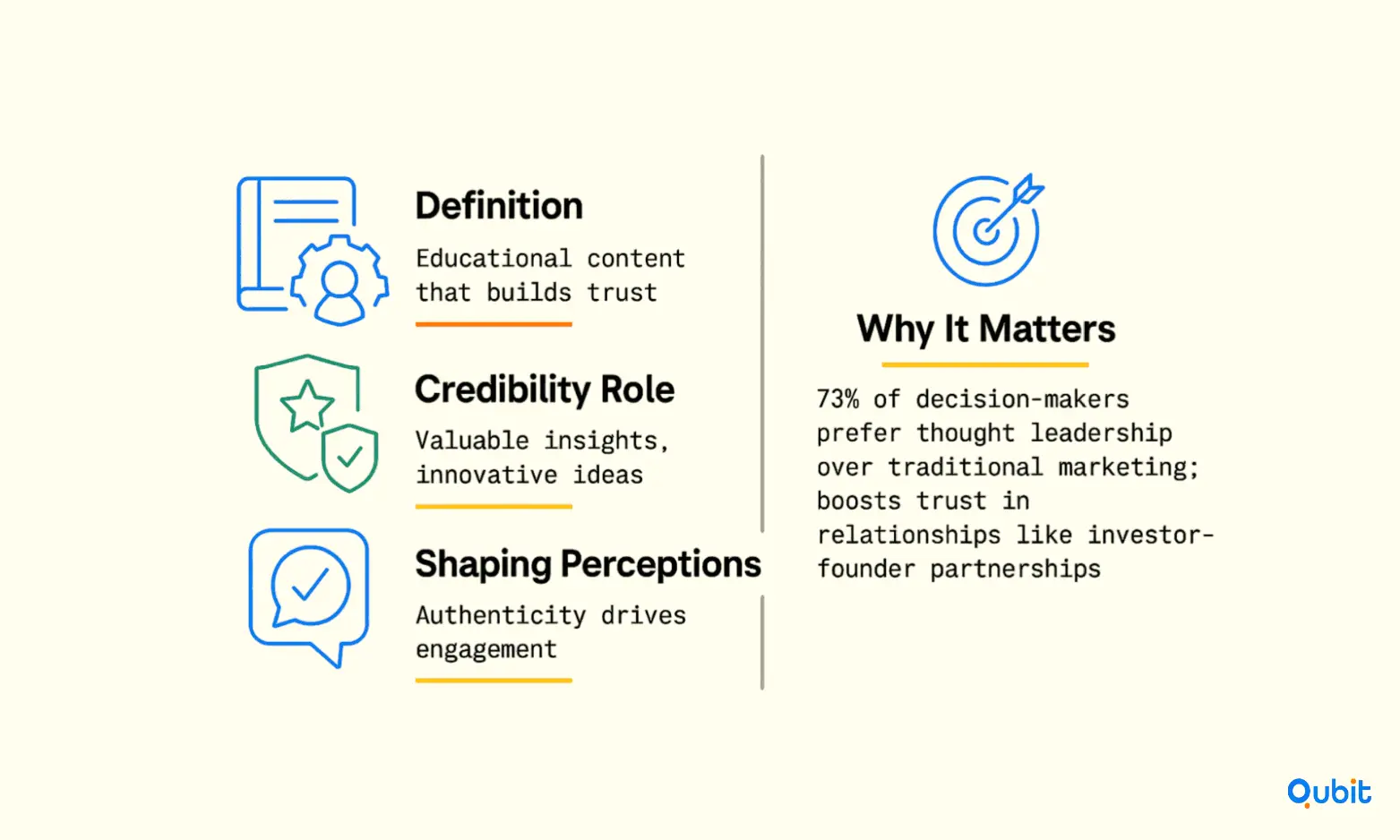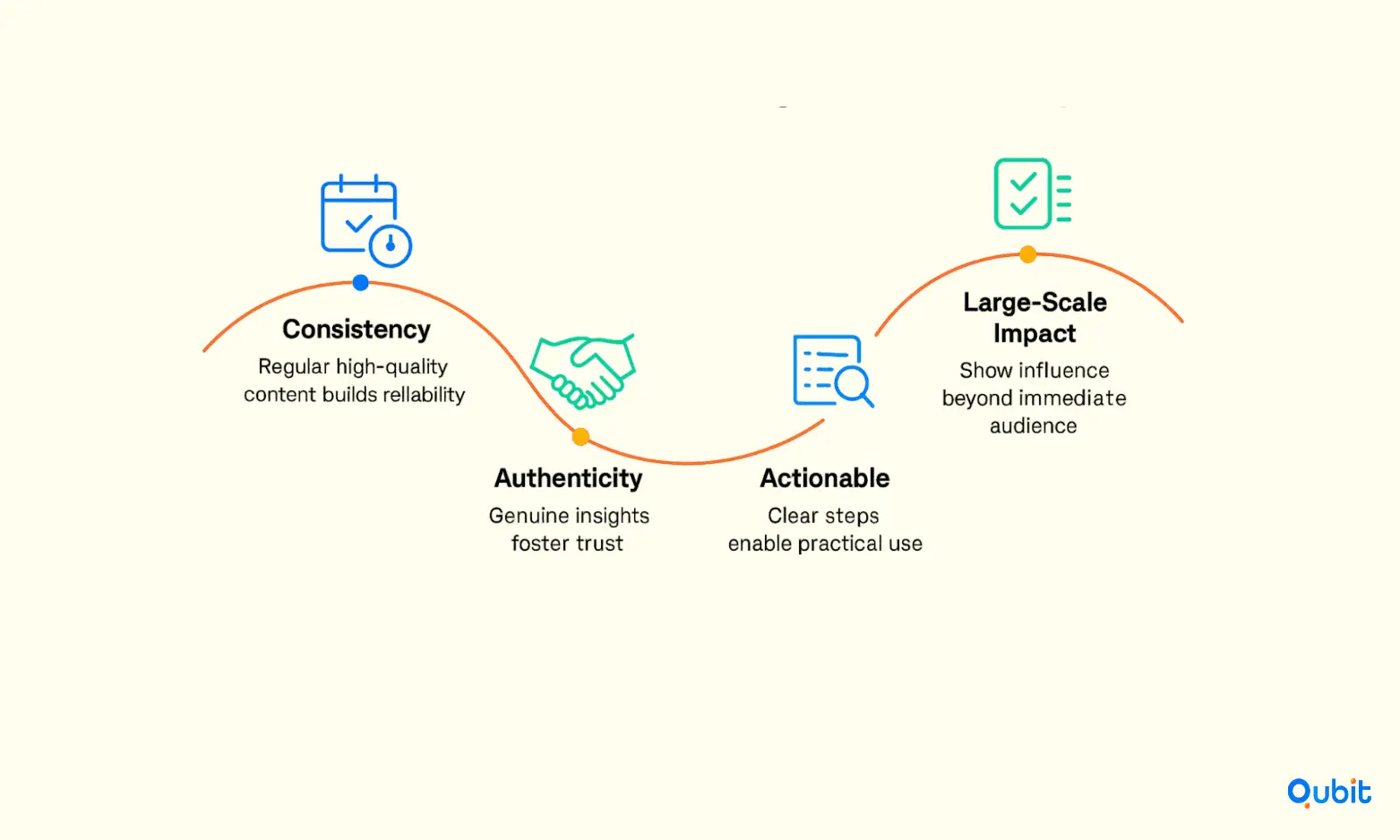Trust is the cornerstone of any successful relationship, especially between investors and founders. For investors, establishing credibility is not just about financial backing—it’s about demonstrating expertise, vision, and a deep understanding of the startup ecosystem. Thought leadership plays a pivotal role in this process. By sharing insights, offering guidance, and positioning themselves as industry experts, investors can build the trust necessary to foster meaningful partnerships with founders.
Your overall outreach strategy is framed by the guide that illustrates how to do startup outreach for investors, offering a clear strategic context in which the nuances of thought leadership are enhanced. This blog explores how thought leadership can be harnessed to build investor credibility and earn founder trust. Let’s jump right in.
Understanding Thought Leadership
Thought leadership is more than just a buzzword; it’s a strategic approach to establishing authority and expertise in your industry. At its core, thought leadership involves creating high-quality, educational content that not only informs but also inspires trust among your audience. This trust is critical, as 73% of decision-makers prefer thought leadership over traditional marketing methods.

The Role of Thought Leadership in Building Credibility
Becoming a thought leader means positioning yourself as a go-to resource in your field. This is achieved through consistent delivery of valuable insights, actionable strategies, and innovative ideas. For instance, producing content that addresses industry challenges or emerging trends can significantly enhance your credibility.
Why Thought Leadership Matters
Thought leadership is not just about sharing knowledge; it’s about shaping perceptions. Decision-makers are more likely to trust and engage with brands that demonstrate expertise and authenticity. This trust-building aspect is particularly relevant when fostering relationships, such as learning how to build investor-founder relationships, where credibility plays a pivotal role.
By focusing on thought leadership, you can differentiate yourself from competitors, foster deeper connections with your audience, and ultimately drive meaningful engagement.
Developing a Thought Leadership Strategy
Establishing a thought leadership strategy requires a clear roadmap to ensure your efforts resonate with your audience and achieve measurable results. This section breaks down the process into actionable steps, focusing on goal-setting, audience analysis, content creation, and distribution methods.
1. Define Your Objectives
Start by identifying the purpose behind your thought leadership strategy. Are you aiming to build brand authority, attract investors, or drive engagement? Setting specific, measurable goals will help guide your efforts and provide benchmarks for success. For example, citing the ROI of thought leadership is 156% can support the case for investing in a comprehensive strategy.
2. Understand Your Audience
Knowing your audience is crucial for crafting impactful content. Use tools like Google Analytics to analyze audience demographics, interests, and behaviors. This data will help you tailor your messaging to address their needs and preferences effectively.
3. Choose Relevant Topics
Focus on topics that align with your expertise and resonate with your audience. Consider emerging trends, industry challenges, or frequently asked questions within your niche.
4. Diversify Your Distribution Channels
To maximize reach, distribute your content across multiple platforms. Combine blog posts, social media updates, podcasts, and webinars to engage your audience wherever they are most active. Ensure your strategy remains dynamic by regularly evaluating the performance of each channel and adjusting accordingly.
Crafting a thought leadership strategy is not a one-time effort but an ongoing process that evolves with your goals and audience needs.
Best Practices and Key Elements
Establishing credibility through thought leadership requires a strategic approach that balances consistency, authenticity, and actionable insights. By adhering to proven best practices, businesses can position themselves as trusted authorities in their industries.

1. Maintain Consistency Across Channels
Consistency is the cornerstone of effective thought leadership. Regularly publishing high-quality content across multiple platforms ensures that your audience remains engaged and perceives your brand as reliable. For example, 66% of institutional asset management professionals consider thought leadership a critical factor in evaluating firms, underscoring the importance of a steady and impactful presence.
2. Prioritize Authenticity
Authenticity builds trust, which is essential for long-term credibility. Thought leaders who share genuine insights and experiences resonate more deeply with their audience. This principle is evident in the Rise of FinFluencers on LinkedIn, where professionals use personal branding to connect authentically with their networks.
3. Use Data-Driven Insights
Educational content backed by data not only informs but also establishes authority. Citing credible sources, such as evidence supporting the influence of thought leadership in asset management, reinforces your expertise and adds weight to your arguments.
4. Focus on Actionable Content
Content that provides clear, actionable steps empowers your audience to apply insights effectively. This approach aligns with the strategies outlined in the investor outreach email template for founders, which details practical communication techniques that complement a broader thought leadership framework.
5. Highlight Large-Scale Impact
Demonstrating the broader implications of your expertise can further solidify your position as a thought leader. Referencing initiatives like System-level Investing Champions illustrates how thought leadership can drive meaningful change on a larger scale.
By integrating these best practices, businesses can create a robust thought leadership strategy that not only educates but also inspires trust and action.
Event-Driven Thought Leadership
Strategic participation in industry events can transform your brand into a recognized thought leader. These gatherings offer a platform to showcase expertise, connect with influential figures, and amplify your voice within your niche. By approaching events with a clear plan, businesses can unlock opportunities that extend far beyond the event itself.
1. Maximize Event Opportunities
To make the most of industry events, preparation is key. From crafting compelling presentations to curating interactive experiences, every detail should align with your thought leadership goals. Incorporating Data Visualization and Interactive Content during event presentations can captivate audiences and leave a lasting impression. Engaging visuals not only simplify complex ideas but also make your message more memorable.
2. Build Relationships with Key Influencers
Events are fertile ground for networking with industry leaders, potential partners, and decision-makers. These connections can open doors to collaborations, mentorships, and even new business opportunities. A great example is Blackstone's Stephen Schwarzman Thought Leadership, which significantly enhanced market visibility through event-driven efforts. By fostering relationships at events, Schwarzman positioned himself as a go-to authority in his field.
3. Repurpose Event Content for Long-Term Impact
The value of an event doesn’t end when the lights go out. Repurposing event content—such as turning keynote speeches into blog posts, podcasts, or videos—can extend its reach and reinforce your leadership credentials. For instance, techniques from the Guide to building a brand via thought leadership can be applied to enhance visibility at events and beyond. This approach ensures that your insights continue to resonate with your audience long after the event concludes.
For businesses aiming to create value beyond traditional methods, examining how investors add value beyond capital offers additional perspectives. This strategy aligns seamlessly with the broader goals of thought leadership, emphasizing the importance of creating meaningful, long-term connections.
By strategically investing in events, your brand can not only gain visibility but also solidify its position as a trusted industry authority.
Conclusion
Earning the trust of founders requires more than just financial backing; it demands a thoughtful approach grounded in authenticity and expertise. By focusing on key strategies—such as understanding the nuances of thought leadership, crafting a well-defined strategic plan, implementing best practices, and utilizing events to enhance visibility, investors can position themselves as credible and approachable partners.
Equally important is the role of data-driven insights and genuine communication. These elements not only establish credibility but also foster meaningful connections that resonate with founders on a deeper level.
For investors looking to refine their approach, we offer tailored solutions to help you stand out. Our Investor Discovery and Mapping service provides actionable insights to connect with founders effectively. Let’s work together to elevate your thought leadership strategy and build lasting relationships.
Key takeaways
- Thought leadership is essential for establishing credibility and trust between investors and founders.
- 73% of decision-makers rely on thought leadership over conventional marketing techniques.
- A step-by-step, strategy-driven approach ensures sustainable and effective thought leadership.
- Consistency, authenticity, and data-driven insights are critical components to long-term success.
- Leveraging industry events and multi-channel distribution significantly enhances thought leadership impact.
Frequently asked Questions
What is thought leadership in investing?
Thought leadership in investing is the practice of leveraging credibility, expertise, and unique insights to position oneself as a trusted authority within the investment industry.






